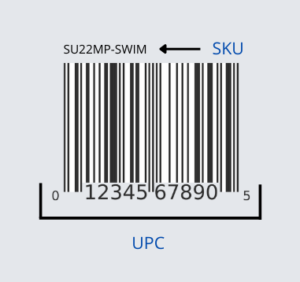Small owner-managed warehouses are able to keep track of products quite easily since there are only a few SKUs to manage. Once you get into thousands of different products or SKUs, manual management becomes difficult especially when you’re keeping track of sales orders and purchase orders to determine profitability. Before getting into SKU Management, it’s first important that you understand what a SKU is, and what other codes are associated with product tracking and traceability.
What is a SKU?
A SKU or Stock Keeping Unit is an alphanumeric unique identification code used to identify a product (or service) and track its movement. A SKU holds information such as product details and allows distributors and retailers to differentiate one small red t-shirt from another small red t-shirt. SKUs are created primarily for inventory management but also help to prevent theft and assist employees.
Good SKU management starts with creating meaningful SKUs that includes information such as color, size, style, or material. This will make your life easier when it comes to finding products, reporting and understanding product profitability. Later in this post you will see what a meaningful SKU looks like.
What is a UPC?
A UPC is short for Universal Product Code also associated to one each of a product. (One each could be a single water bottle or a case of water bottles. Each = Last Sellable Unit) The UPC comprises of a barcode and a unique 12-digit number.
The first 6 digits are a unique identification code used to establish the manufacturer. The next 5-digits are the item number for individual products (these numbers are chosen by the manufacturer). The last digit is the check digit for minimizing errors.
Example: Let’s say you are a wholesale distributor buying the same product, maybe a chair, from two different suppliers. When just looking at the chairs, no one would be able to tell that they came from separate warehouses. Since each chair has its own unique UPC, if one is defective, the retailer and distributor can use the UPC to report the defect to the correct supplier.
Alright, let’s get back into SKU Management
Below we outline a few key best practices for SKU Management:
1. Create Meaningful SKUs
In order to aid identification, include product properties such as color, size and type to keep it straightforward so that warehouse employees and retailer workers are all able to understand the series of numbers and letters. Also, be mindful of confusing letters or numbers, an O and a 0 are often confused so it’ll be best to stay away.
Example: Summer 2022 Pink Medium Swim Shorts = SU22MP-SWIM
2. Group SKUs for Warehouse Management
Depending on your business, you can group all your summer swim shorts together or you could group all your size mediums together to aid the picking process for warehouse employees. When manually walking the warehouse, it’s not uncommon for an employee to accidentally put a medium with the rest of the smalls. Once you decide the business process that works for your company, barcode scanning abilities such as Blue Link's Mobile Scanning App speeds up the warehouse picking process and eliminates human error by ensuring the worker picks and puts back inventory where it belongs.
3. Use Historical Data to Remove Unpopular SKUs
Holding on to dead stock can harm your business more than you think. Dead stock is inventory that has been sitting in your warehouse for some time and isn’t selling due to low demand. ERP Software that tracks SKUs can produce historical data so you can see sales by product and determine which SKUs to get rid of. One way of removing dead stock is by creating a kit that ERP software can help you do.











